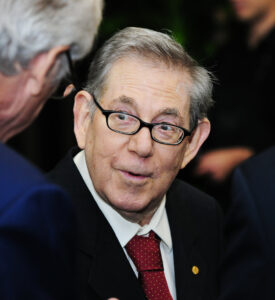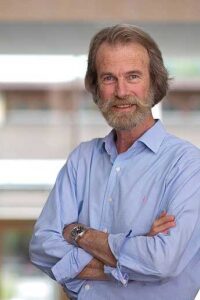
With profound sadness, the International Association of Meteorology and Atmospheric Sciences (IAMAS) announces the passing of Richard Peer Wayne. Richard was born on the 5th of December 1938 in Worthing and died at his home in Oxford, aged 85, on the 18th December 2023. He is well remembered by the IAMAS community in particular for his role on the organising committee (LOC) of the Commission of Atmospheric Chemistry and Global Pollution (CACGP) Symposium on Tropospheric Chemistry with Emphasis on Sulphur and Nitrogen Cycles and the Chemistry of Clouds. This conference, which was a milestone for IAMAS, took place in Christ Church and at the University of Oxford in September 1983. In addition Richard made pioneering contributions to our understanding of atmospheric sciences.
Richard was born and grew up in Worthing, Sussex, UK. During the Second World War, he and his family moved for a time to Lancashire. After Richard returned to Worthing, he enjoyed rescuing scientific instruments from aircraft that had crash-landed in the local area. His experiences, as a child growing up during the second world war and the early post war years, influenced Richard for the rest of his life. In this respect he became an aircraft enthusiast, internationalist and pro-European. Richard attended Worthing Grammar School from 1949 and was an excellent student. He developed passions for electronics and music, which he shared with his beloved father. During his grammar school days Richard also had the good fortune to meet his future partner and wife Brenda. Whilst in the sixth form, Richard won a scholarship to Trinity College at the University of Cambridge, going up to study the Natural Sciences Tripos in 1957. He again excelled at his studies, graduating with a first class B.A. (hons) in 1960.
The first research paper, published by Richard in 1960, addressed the coupling of polymers and resulted from his working as a student with Professor C. H. Bamford FRS at Courtaulds’ Research Laboratory in Maidenhead. In Michaelmas term 1960, Richard began research as a graduate student in the Department of Physical Chemistry at the University of Cambridge, under the supervision of the head of department Professor Ronald G.W. Norrish, who in 1967 was one of the winners of the Nobel Prize in Chemistry for his contributions to the study of extremely fast chemical reactions. Professor Norrish advised Richard to study ozone (O3) chemistry during his doctorate. Richard enjoyed explaining later that, as he received no subsequent countermanding order, he continued to work on O3chemistry for the rest of his research life! As a graduate student, Richard also enjoyed, in his own words, “moonlighting” with Brian A. Thrush and his doctoral student Michael Clyne. Both Brian and Michael became lifelong friends of Richard. Together they investigated the spectroscopy and kinetics of reactions of halogens and the oxides of nitrogen with O3. These kinetic and spectroscopy studies during his doctorate were some of the first quantitative investigations of photochemistry and chemistry of ozone and key atmospheric free radicals.
Richard successfully completed his doctorate, and then, from 1963, moved to a post-doctoral fellowship sponsored by Courtaulds in the research group of Professor C H Bamford FRS at the Department of Inorganic, Physical and Industrial Chemistry at the University of Liverpool. Photochemistry and the study of photosensitized polymerisation of selected organic compounds were now his focus. However, Richard’s success in research led to his being appointed in 1965 to be a Departmental Demonstrator in the Physical Chemistry Research Laboratory at the University of Oxford and elected a Tutor and College Lecturer at Christ Church. In the following year, he was appointed to an Official Studentship at Christ Church, and in 1967 was awarded a University Lectureship. In 1973 he was elected as Dr. Lee’s Reader in Chemistry at Christ Church, a prestigious position that he held until his retirement in 2006. He was awarded the title of Professor in Oxford in 1996.
Richard was a dedicated and outstanding tutor and lecturer, who was regarded with great respect and affection by his pupils and colleagues. Though demanding in tutorials, he was able to draw the very best out of his students. Richard was the author of several text books on Photochemistry and Atmospheric Chemistry, which became standard reading for undergraduates and graduates. He and Brenda enjoyed socialising with colleagues, pupils and friends and were generous hosts, holding many fondly remembered social events at the Lee Reader’s House in St Giles.
After moving to Oxford, Richard quickly built up an active research group studying Photochemistry, and Atmospheric Chemistry. In addition, he provided support to the late Gordon M. B. Dobson, the pioneer of remote sensing atmospheric O3 measurements. These were made from Dobson’s home, originally at Boar’s Hill and later at Shotover, Oxford, from the early 1920s up until his death in 1976. Richard calibrated Dobson’s spectrophotometer for him by using concentrated mixtures of known amounts of O3 in molecular oxygen (O2) stored in glass flasks. The latter he transported to Shotover by travelling on the Oxford buses! For a variety of reasons, this would probably not be allowed by health and safety regulations nowadays! Between 1963 and the early 1970s Richard’s research was focused on fundamental studies of photochemical and chemical reactions, involving: a) studies of polymerisation through photosensitised approaches, b) studies of the methylene radical CH2, c) the photolysis and the products of the photolysis of O3, d) the reactions of the excited oxygen molecule O2 (1Δg) and its role in atmospheric chemistry; e) the reaction of oxygen atoms (O) and hydrogen atoms (H)with nitric acid (HNO3), f) the observation of the emissions of excited hydroperoxyl (HO2) and deuterated hydroperoxyl (DO2) molecules; and g) the NO2 chemiluminescence from the reaction of NO with O3.
In the late 1960s and early 1970s, the scientific recognition of, and public concern about, the impact of human activity on atmospheric composition from the local to the global scale led to the relatively small academic research field of atmospheric chemistry beginning to grow rapidly Richard was a key member of an international group of younger scientists, investigating the sources and sinks of stratospheric O3. In this context, from 1969 to 1971, Richard and his colleague John T. Houghton from Atmospheric Physics hosted and advised Paul J. Crutzen of Stockholm University during his post-doctoral fellowship at the Clarendon Laboratory of the University of Oxford. Paul, Mario Molina and F. Sherwood Rowland were later awarded the Nobel Prize for Chemistry in 1995 “for their work in atmospheric chemistry, particularly concerning the formation and decomposition of ozone”. Whilst at Oxford, Paul published a key paper proposing that oxides of nitrogen NOx (= Σ (nitric oxide (NO) and nitrogen dioxide (NO2))) in the stratosphere would catalytically destroy stratospheric O3. He identified the stratospheric source of NOx to be the transport of tropospheric nitrous oxide (N2O), generated by the bacterial decomposition of natural and artificial fertiliser ammonium nitrate (NH4 NO3). He also noted that the emissions of high flying aircraft were also a potential stratospheric source. Independently, Harold S. Johnston at the University of California pointed out that emissions of NOx from high flying aircraft might be a threat to the stratospheric ozone layer, which protects the biosphere and humans from biologically damaging UV-B radiation. This implied that fleets of high flying aircraft, such as the then new Anglo-French Concorde, might deplete stratospheric O3. This first identification of human activity having a global impact on atmospheric composition was then followed by the proposal by Molina and Rowland in 1974 that chlorofluorocarbon compounds, which are produced and emitted by human activity into the troposphere, are transported to the stratosphere, where they are photolyzed and react with the excited oxygen atoms to release chlorine atoms (Cl) and chlorine monoxide (ClO), which then catalytically destroy stratospheric O3. After the unexpected discovery of the loss of ozone in the lower stratosphere during spring over Antarctica in 1985, which became known as the “ozone hole”, international efforts intensified to explain the origin of this phenomenon and to assess and mitigate this anthropogenic threat to stratospheric ozone. Richard and his research group played an important role in the evolving research in atmospheric chemistry: the goal being to improve our understanding of the chemical reactions that determine the amounts and distributions of stratospheric O3, short lived climate pollutants and long lived greenhouse gases. Many of the research programmes were initiated in the UK by COMESA (Committee on the Effects of Stratospheric Aircraft) in 1972 and later supported by UK NERC (Natural Environment Research Council) and the EU.
Richard and his group exploited different kinetic techniques to detect short lived reactive free radicals and atmospheric gases, including resonance fluorescence, laser induced fluorescence and absorption spectroscopy. Some good examples of the sophisticated approaches used were the studies of the reactions of oxygen atoms (O), hydroxyl (OH) and HO2, chlorine atoms (Cl), chlorine monoxide (ClO), bromine atoms (Br), bromine monoxide (BrO), iodine atoms (I), iodine monoxide (OIO), and the nitrate radical (NO3). Other foci of Richard’s research were the investigation of structure activity relationships to estimate rate coefficients for atmospheric constituents which are difficult to measure in the laboratory. This body of research contributed to our understanding of reactivity in the gas phase, and improved the accuracy of atmospheric models of mesospheric, stratospheric and tropospheric chemistry. The latter is required to assess the threat of anthropogenic activity to the stratospheric ozone layer and its impact on tropospheric pollution in a warming world. The societal and international environmental policy response to the global threat to the stratospheric ozone layer led to the Vienna Convention for the Protection of the Ozone Layer in 1985 and its Montreal Protocol in 1987 and amendments. The latter effectively banned the production and release of the Ozone Depleting Substances. Similarly, at least in Europe and North America, much progress has been made by the United Nations Economic Commission for Europe (UNECE) Convention on Long-Range Transboundary Air Pollution (CLRTAP). In comparison, the efforts to limit man-made climate change have not as yet been successful.
During his career, Richard published over 200 research papers, with a Hirsch Index of 40, demonstrating the continuing importance of his research, nearly two decades after his retirement. Equally importantly, Richard wrote a series of successful books on photochemistry and atmospheric chemistry which remain popular for undergraduate and graduate students in the atmospheric sciences. The two reviews of nitrate and halogen chemistry, which he initiated, led and edited remain well read. He educated three generations of scientists, who have become leading academics, leaders of industry, government and NGO advisors, and educators. In 1999 he received the Royal Society of Chemistry’s Reaction Kinetics award, in 2001 an Honorary Doctorate from the University of Castilla-La Mancha and in 2012 the Haagen Smit Prize for his review of the nitrate radical in the atmospheric environment.
His being recognised as a renowned authority in the fields of Atmospheric Chemistry (both terrestrial and extra-terrestrial) and Photochemistry, led to Richard serving on key advisory committees of the UK government and the European Union. In this respect, Richard was a tireless advocate for atmospheric research, which is both of scientific curiosity and societal relevance. Richard retired in 2006, but continued doing some research, and teaching. In addition he pursued his passion for photography and music, and spent time with his family and friends. It was typical of Richard that, as his health declined, he often interviewed his doctor’s medical students, instructing them on the characteristics and treatment of his heart problems!
Richard was charismatic and his enthusiasm for science and life made him a popular attendee at scientific conferences. He was often the person switching off the lights at the end of a long day’s work and an evening enjoying food, drink and discussion, but also the first speaker the next morning, admittedly sometimes wearing sunglasses. Perhaps Bob Huie of NBS / NIST best summed up Richard’s impact on his friends and colleagues by writing the following: “About every one of my generation of researchers has at least one Richard Wayne story.”
On a personal note, JPB one of the authors, points out the following. He first met Richard in 1976, when Richard visited with Brian Thrush, the supervisor of his doctoral research.
He then travelled with Richard and Brenda and a group of young UK scientists to the NATO winter school Arabba, Italy, in March 1977. The latter turned out to be an important meeting of European atmospheric chemists. He was very fortunate that Richard became his mentor. He later worked and collaborated with Richard, who became one of his dearest friends.
In conclusion, Richard was a colossus of a man and a pioneer of modern atmospheric chemistry. He was bright light who entered the lives of all who knew him.
Rest in peace Richard, and thank you for making science and life so enjoyable and fun.
John P. Burrows, Brenda Wayne, Carol Wayne and Andrew Wayne 15th March 2024


